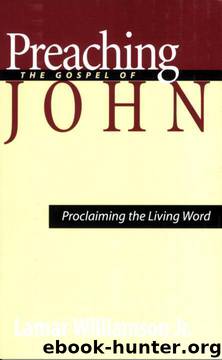Preaching the Gospel of John:Â Proclaiming the Living Word by Lamar Williamson Jr

Author:Lamar Williamson Jr. [Lamar Williamson Jr.]
Language: eng
Format: epub
Published: 2011-08-13T01:18:00+00:00
IfJesus' foreknowledge ofJudas's betrayal (13:11, 18-19) is evidence of his oneness with God, his being "troubled in spirit" (13:21 a) shows that he is one with us. His soul was troubled when he confronted the imminence of his own death (12:27), and his spirit is troubled by the thought of betrayal by one of his chosen disciples (6:70-71; 13:11, 18). His announcement of the impending betrayal is introduced by the solemn formula, "Very truly, I tell you" (13:21b).
The scene in which Jesus reveals the identity of the betrayer is important in all four Gospels,2 but John's account is the most circumstantial. "The disciple whom Jesus loved" is introduced here for the first time, seated by Jesus at the Last Supper (13:23) and acting as intermediary between Peter and Jesus. He appears again at the foot of the cross (10:26), entering the empty tomb (20:2), and at the Sea of Tiberias (21:7). Rumor had it that he would live until Jesus comes again (21:20, 23). Although he is never named in the text of the Fourth Gospel, he is referred to as its chief witness and author (21:24). Church tradition since the late second century has identified him as John, the son of Zebedee, one of the Twelve. In recent years some have thought he symbolizes the community for which this Gospel was written. The debate about his identity is interminable and inconclusive. What the text states plainly is that he was an eyewitness who was particularly close to Jesus-literally, "reclining in Jesus' bosom" (13:23). In the prologue Jesus is described as "close to the Father's heart"-literally, "on the bosom of the Father" (1:18). For the evangelist, the beloved disciple is as close to Jesus as Jesus is to God, a closeness thatJesus prays might characterize all believers (17:23). The suggestion that the beloved disciple symbolizes the Johannine community is understandable.
When Jesus predicts that one of the disciples reclining with him at table will betray him (13:21), the beloved disciple, at Peter's request, asksJesus, "Lord, who is it?" (13:2.5). Jesus answers by means of another symbolic act that he explains in advance to the beloved disciple (13:26). In a basic gesture of Oriental hospitality Jesus perhaps picks out for Judas a choice morsel of food as a special act of esteem (cf. Ruth 2:14). By accepting the piece of bread without changing his plan to betray Jesus, Judas shows that he has chosen for Satan.3
Jesus' command to Judas after he has received the bread and Satan has entered him-"Do quickly what you are going to do" (13:27)-is heard but not understood by the others at table. John uses their misunderstanding to inform readers that Judas is treasurer and purchasing agent for Jesus and his disciples, that the Passover festival still lies in the immediate future, and that as a group they give alms to the poor (13:28-29). Jesus is in full control of the situation.Judas should act quickly becauseJesus' hour has come. Judas obeys and goes out into the darkness. The
Download
This site does not store any files on its server. We only index and link to content provided by other sites. Please contact the content providers to delete copyright contents if any and email us, we'll remove relevant links or contents immediately.
| Guides | New Testament |
| Old Testament |
The Five People You Meet in Heaven by Mitch Albom(3476)
The Secret Power of Speaking God's Word by Joyce Meyer(2978)
Real Sex by Lauren F. Winner(2968)
Name Book, The: Over 10,000 Names--Their Meanings, Origins, and Spiritual Significance by Astoria Dorothy(2940)
The Holy Spirit by Billy Graham(2894)
0041152001443424520 .pdf by Unknown(2785)
ESV Study Bible by Crossway(2733)
How The Mind Works by Steven Pinker(2729)
Ancient Worlds by Michael Scott(2627)
The Meaning of the Library by unknow(2506)
Churchill by Paul Johnson(2506)
The ESV Study Bible by Crossway Bibles(2502)
The Gnostic Gospels by Pagels Elaine(2472)
MOSES THE EGYPTIAN by Jan Assmann(2374)
Jesus by Paul Johnson(2310)
City of Stairs by Robert Jackson Bennett(2309)
The Complete Dead Sea Scrolls in English (7th Edition) (Penguin Classics) by Geza Vermes(2236)
Ancient Near Eastern Thought and the Old Testament by John H. Walton(2196)
The Nativity by Geza Vermes(2180)
